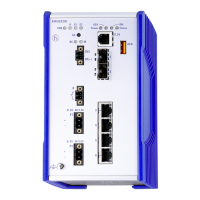WAN > SHDSL/EFM > Statistics
WAN
RM GUI HiSecOS EAGLE20/30
Release
3.0
09/2015
271
Buttons
Port Side Displays the operating mode that the device applies to the pairs.
Possible values:
office
The port is operating in the operating mode “Office”.
subscriber
The port is operating in the operating mode “Remote”.
unknown
No operating mode is assigned to the pairs.
or
Contradictory operating modes are assigned to the pairs. See the
WAN >
SHDSL/EFM
> Configuration
dialog, "Operation mode" field.
Number of PMEs Displays the number of pairs that the port is using at the moment.
PAF In Errors Displays the number of erroneous received packets that the device has
discarded on the port.
PAF In Small
Fragments
Displays the number of received fragments smaller than 64 bytes that the
device has discarded on the port.
PAF In Large
Fragments
Displays the number of received fragments larger than 512 bytes that the
device has discarded on the port.
PAF In Bad
Fragments
Displays the number of received fragments that the device discarded on the
port because they do not fit into the sequence expected by the
defragmentation function.
PAF In Lost
Fragments
Displays the number of fragment gaps that the device received on the port.
PAF In Lost Starts Displays the number of missing StartOfPacket indicators expected by the
defragmentation function which the device has detected on the port.
PAF In Lost Ends Displays the number of missing EndOfPacket indicators expected by the
defragmentation function which the device has detected on the port.
PAF In Overflows Displays the number of received fragments that the device has discarded
on the port, because this would have led to a buffer overflow of the
defragmentation function.
Button Meaning
Set Transfers the changes to the volatile memory (
RAM
) of the device and
applies them to the device. To save the changes in the non-volatile
memory, proceed as follows:
Open the
Basic Settings > Load/Save
dialog.
In the table, highlight the desired configuration profile.
If in the "Selected" column the checkbox is
unmarked
, click the
"Select" button.
Click the "Save" button.
Parameters Meaning

